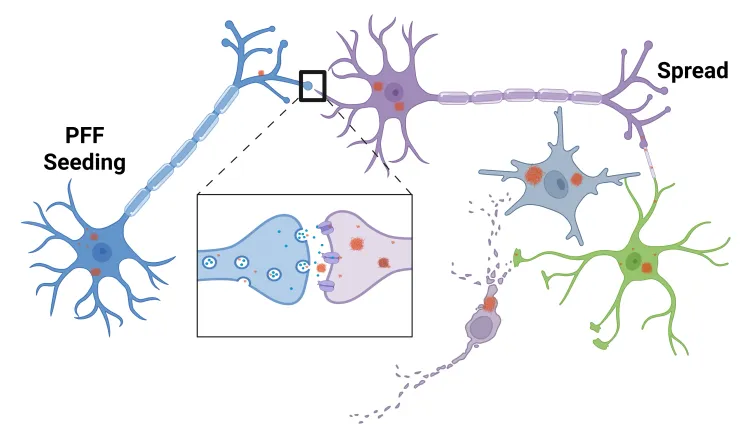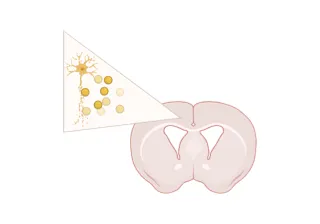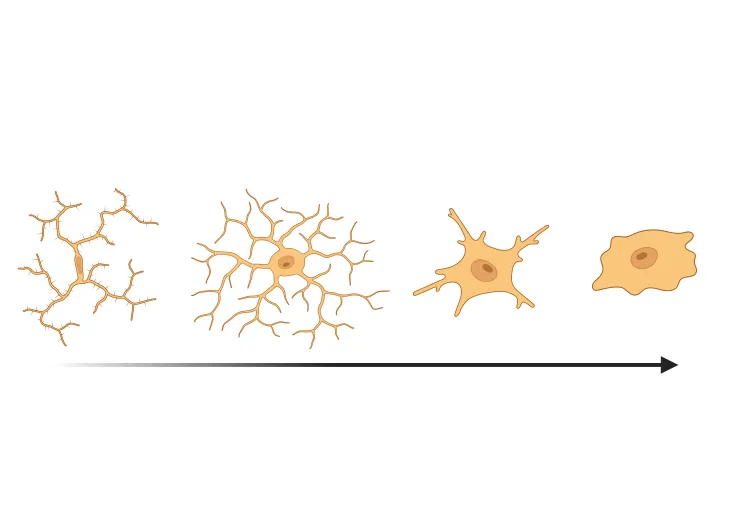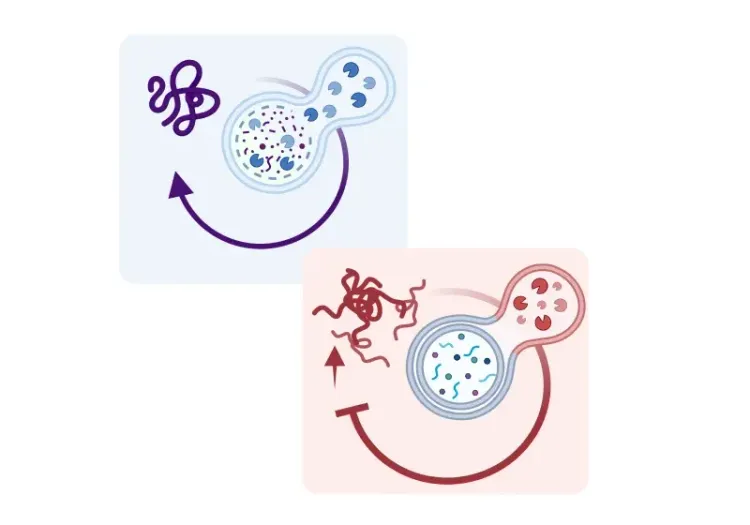Neurodegeneration & Neuroinflammation in the AAV-Synuclein Mouse Model
Models Overview
At Biospective, we develop and use rigorously characterized rodent models that closely reflect key features of human Parkinson's disease – including α-synuclein aggregation, dopaminergic neuron loss, neuroinflammation, motor impairments, and sleep disturbances. These models are designed to support investigations into disease mechanisms, pathological progression, and early-stage therapeutic effects with strong translational relevance.
Our animal model portfolio emphasizes reproducibility, well-defined phenotypes, and integration of behavioral, imaging, biochemical, molecular, and histopathological endpoints to enable comprehensive preclinical assessment. This scientific foundation allows researchers to explore pathogenic pathways, evaluate candidate therapeutic interventions, and generate robust data to inform drug development efforts.
α-Synuclein Preformed Fibrils (PFF) Models
The pathologic spread of misfolded alpha-synuclein that is characteristic of human Parkinson's disease can be modeled in animal brains by injection of α-synuclein preformed fibrils (PFFs). This "PFF seeding & spreading model" can be induced in transgenic mice overexpressing human α-synuclein or in wild-type mice or rats.
α-Synuclein PFF Model Induction
- Injection of recombinant α-synuclein preformed fibrils (PFFs)
- Applicable to
- M83 transgenic mice overexpressing A53T α-synuclein
- Wild-type mice or rats
α-Synuclein PFF Validated Injection Sites
- Anterior Olfactory Nucleus (AON)
- Medial Forebrain Bundle (MFB)
- Striatum +/- Overlying Cerebral Cortex
α-Synuclein PFF Disease Features Modeled
- Spreading of α-synuclein in a well-defined spatiotemporal pattern
- Neuroinflammation
- Neurodegeneration
- Measurable behavioral impairments
- Motor deficits
- Non-motor symptoms (e.g. sleep disturbances)
These alpha-synuclein PFF PD models are highly reproducible for testing disease-modifying therapeutics.
At Biospective, we have over a decade of experience performing preclinical studies in α-synuclein PFF models of Parkinson's disease to evaluate:
- Biodistribution
- Target engagement
- Mechanism-of-action
- Therapeutic efficacy

Our validated injection sites: Anterior Olfactory Nucelus (AON). Striatum +/- Overlying Cerebral Cortex, and Medial Forebrain Bundle (MFB).

Phosphorylated α-synuclein (pSyn129) IHC of ipsilateral (left) and contralateral (right) piriform cortex 12 weeks after unilateral α-synuclein PFF injection into the AON of an M83+/- mouse.
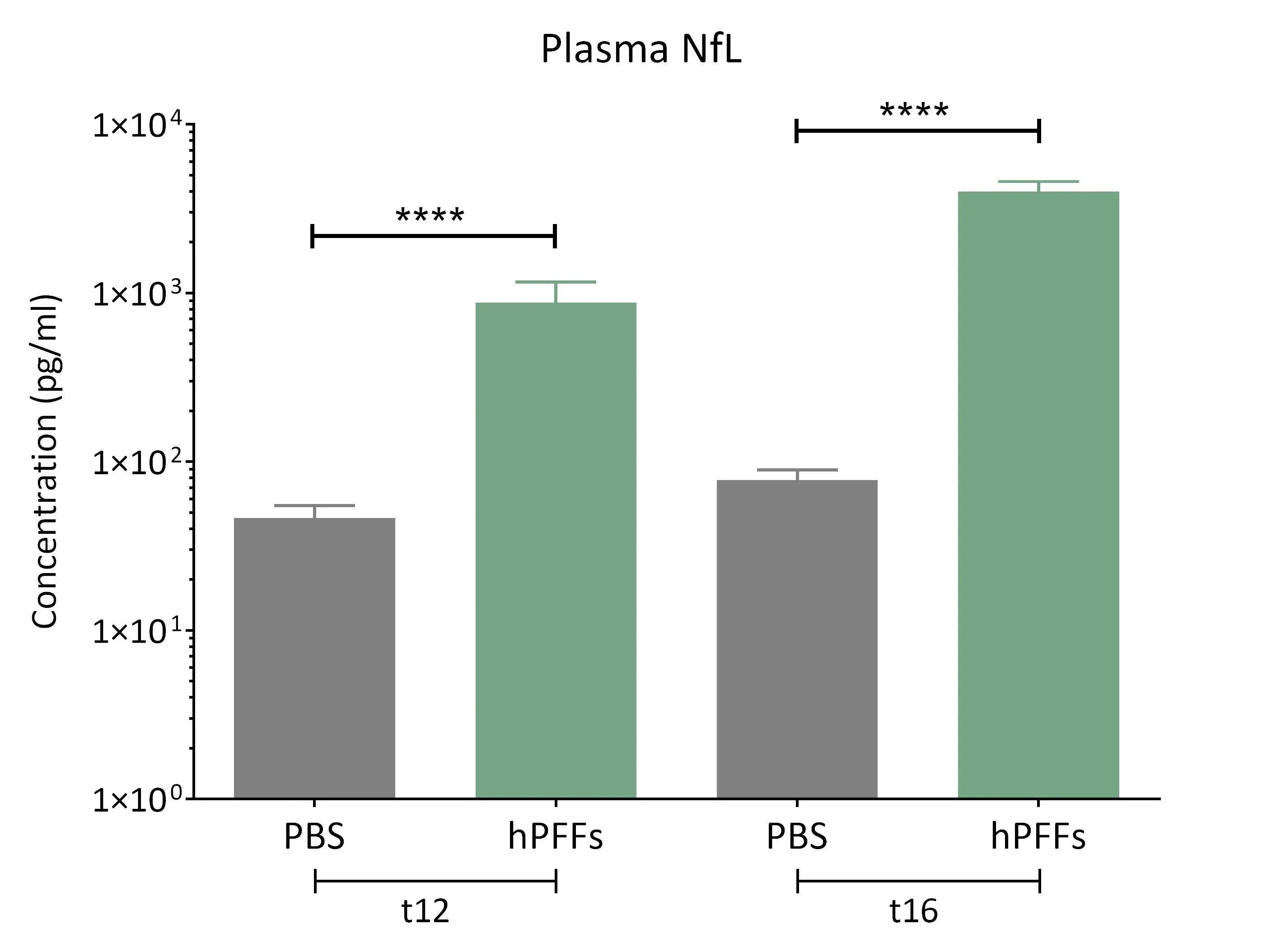
Highly elevated levels of neurofilament light (NF-L) are observed in the plasma from the α-synuclein fibril seeding mice.
AAV-A53T α-Synuclein Models
Generation of α-synuclein pathology in the adult rodent brain can be generated via injection of adeno-associated virus (AAV) vectors. In this mouse model of Parkinson's disease, wild-type (C57BL/6) mice or genetically engineered models undergo stereotaxic injection by experts using digital stereotactic devices with automated microinjectors (for high accuracy and precision) of AAV vectors overexpressing A53T mutant human alpha-synuclein into the vicinity of the substantia nigra pars compacta.
AAV-A53T α-Synuclein Model Induction
- Stereotaxic injection of adeno-associated virus (AAV) vectors overexpressing A53T mutant human α-synuclein
AAV-A53T α-Synuclein Validated Injection Sites
- Substantia nigra pars compacta (SNc)
AAV-A53T α-Synuclein Disease Features Modeled
- Dopaminergic neuron loss in the SNc & denervation of the ipsilateral striatum
- Phosphorylated α-synuclein aggregates in the SNc & striatum
- Neuroinflammation
- Neurodegeneration
- Unilateral motor deficits measurable through
- Rotarod test
- Tail suspension swing test (TSST)
- Cylinder test
- Hindlimb clasping test
At Biospective, we can also perform non-invasive imaging studies (e.g. MRI volumetry, [18F]FDG PET, [18F]DOPA PET) on these AAV-A53T α-synuclein models to generate clinically translational imaging biomarkers (e.g. regional brain atrophy, cerebral glucose hypometabolism, dopaminergic terminal loss).
The AAV-A53T α-synuclein Parkinson's disease model provides a robust and flexible system that is well-suited for studying the effects of therapeutic agents (e.g. small molecules, ASOs, gene therapies, biologics) on pathogenic mechanisms and functional impairments associated with Parkinson's disease.
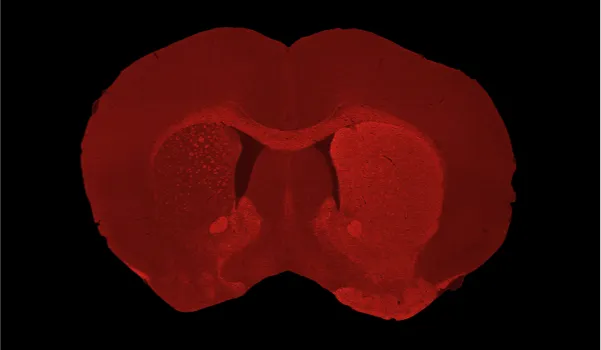
Severe dopaminergic neuron loss and dopaminergic denervation in the ipsilateral (left hemisphere) caudate-putamen following unilateral AAV-hA53Tα-Syn injection into the SNc of a C57BL/6 mouse.
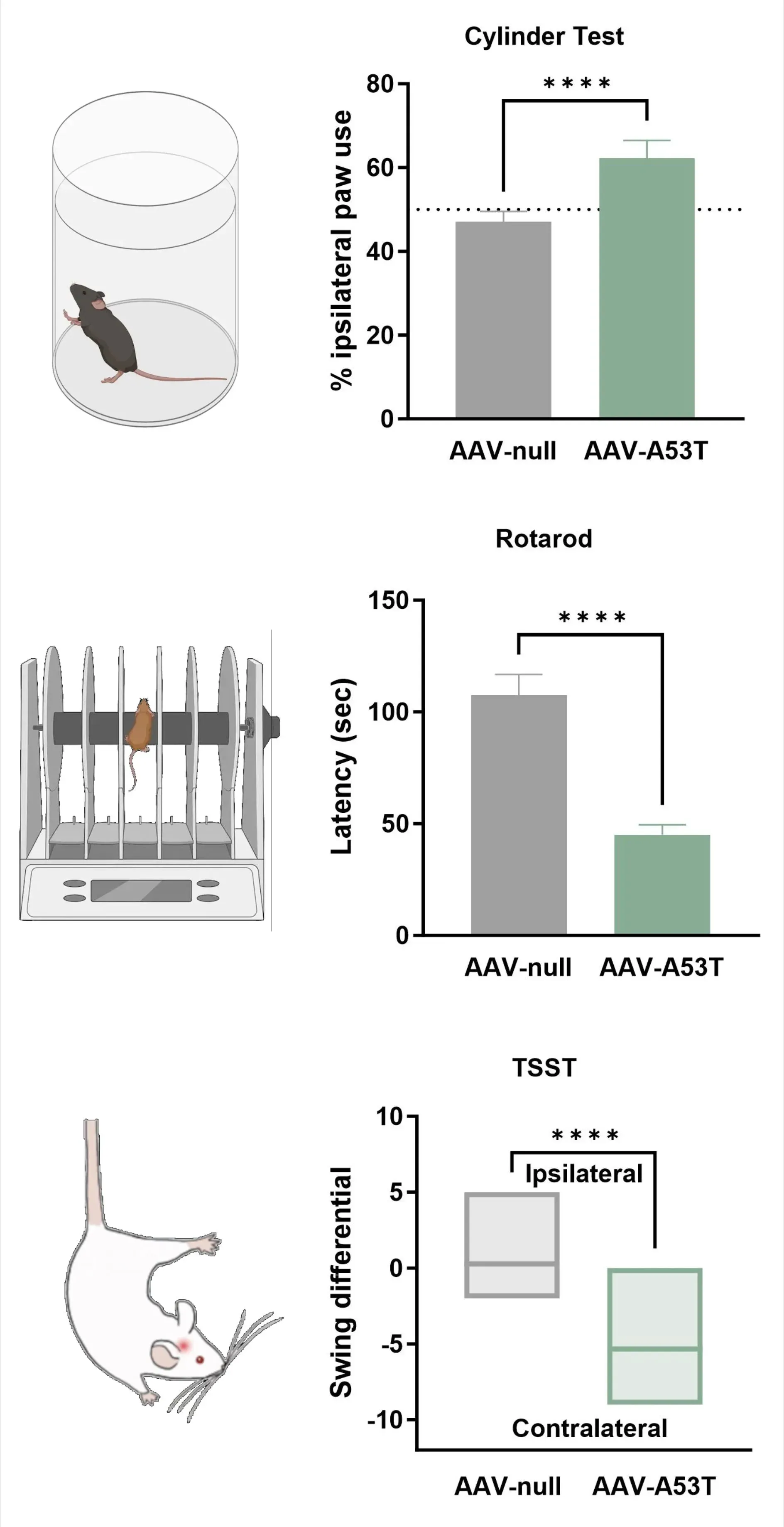
Loss of dopaminergic innervation corresponds with unilateral motor deficits, including increased ipsilateral paw use (Cylinder Test), reduced latency to fall (Rotarod), and increased contralateral swings (Tail Suspension Swing Test).
Which Features of our Parkinson's Disease Models are Translatable to Human Disease?

Immunofluorescence of phosphorylated synuclein (pSyn129) in Parkinson's disease animal models reveals pronounced accumulation in neuronal soma and processes.
Alpha-Synuclein Aggregates
Aggregates of misfolded α-synuclein are a key pathologic feature of human Parkinson's disease. Lewy bodies and Lewy neurites are observed in dopaminergic neurons within the substantia nigra pars compacta, as well as in other brain regions. This misfolded α-synuclein pathology follows a characteristic spatiotemporal progression (Braak, 2003).
In our AAV- and PFF-induced Parkinson's disease animal models, we observe:
- High levels of phosphorylated α-synuclein in neuronal soma and processes
- Robust seeding and spreading of pathology in the PFF models

Activated microglia (red boxes) in the hippocampus of mice injected into the AON with PBS (top) or α-synuclein PFFs (bottom).
Activated Microglia & Reactive Astrocytes
Neuroinflammation is a key pathological feature of Parkinson's disease, with activated microglia and reactive astrocytes playing key roles in pathogenesis (Kam, 2020; Chen, 2023).
In our AAV- and PFF-induced Parkinson's mouse models, we observe:
- Distinct spatiotemporal patterns of neuroinflammatory responses
- Altered microglial and astrocytic morphology, detected using computer vision, machine learning, and deep learning algorithms developed in-house
See our Neuroinflammation Initiative: Microglia, Astrocytes, and Neurodegenerative Diseases
See our Innovation: Microglial Activation in an α-Synuclein Mouse Model of Parkinson's Disease
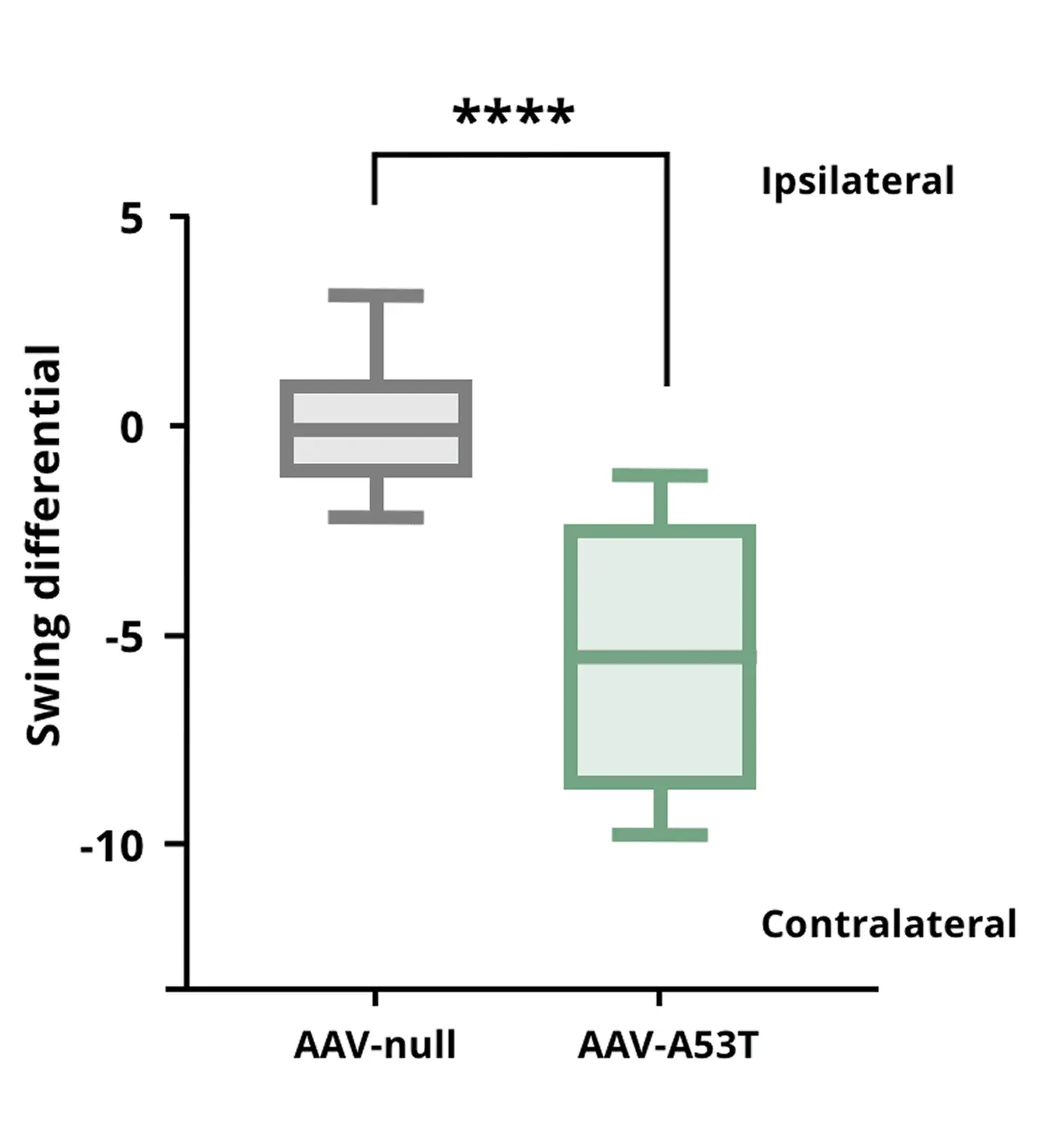
Tail Suspension Swing Test showing that AAV-A53T α-syn mice exhibit increased contralateral swings due to a unilateral dopaminergic deficit, compared to AAV-null control mice.
**** p<0.0001.
Dopaminergic Neuron Loss & Motor Deficits
Extrapyramidal motor symptoms are a hallmark of Parkinson's disease, primarily driven by dopaminergic neuron loss in the substantia nigra pars compacta (SNc) and striatal denervation (e.g. caudate and putamen).
In our Parkinson's models, we induce pathology by targeting the SNc with either:
- AAVs overexpressing α-synuclein, or
- α-synuclein preformed fibrils (PFFs)
See our Resource: Preformed Fibrils – A Guide to Cell and Animal Models
These interventions result in:
- Neurodegeneration of dopaminergic neurons in the SNc
- Loss of dopaminergic terminals in the striatum
- Motor impairments assessed by:
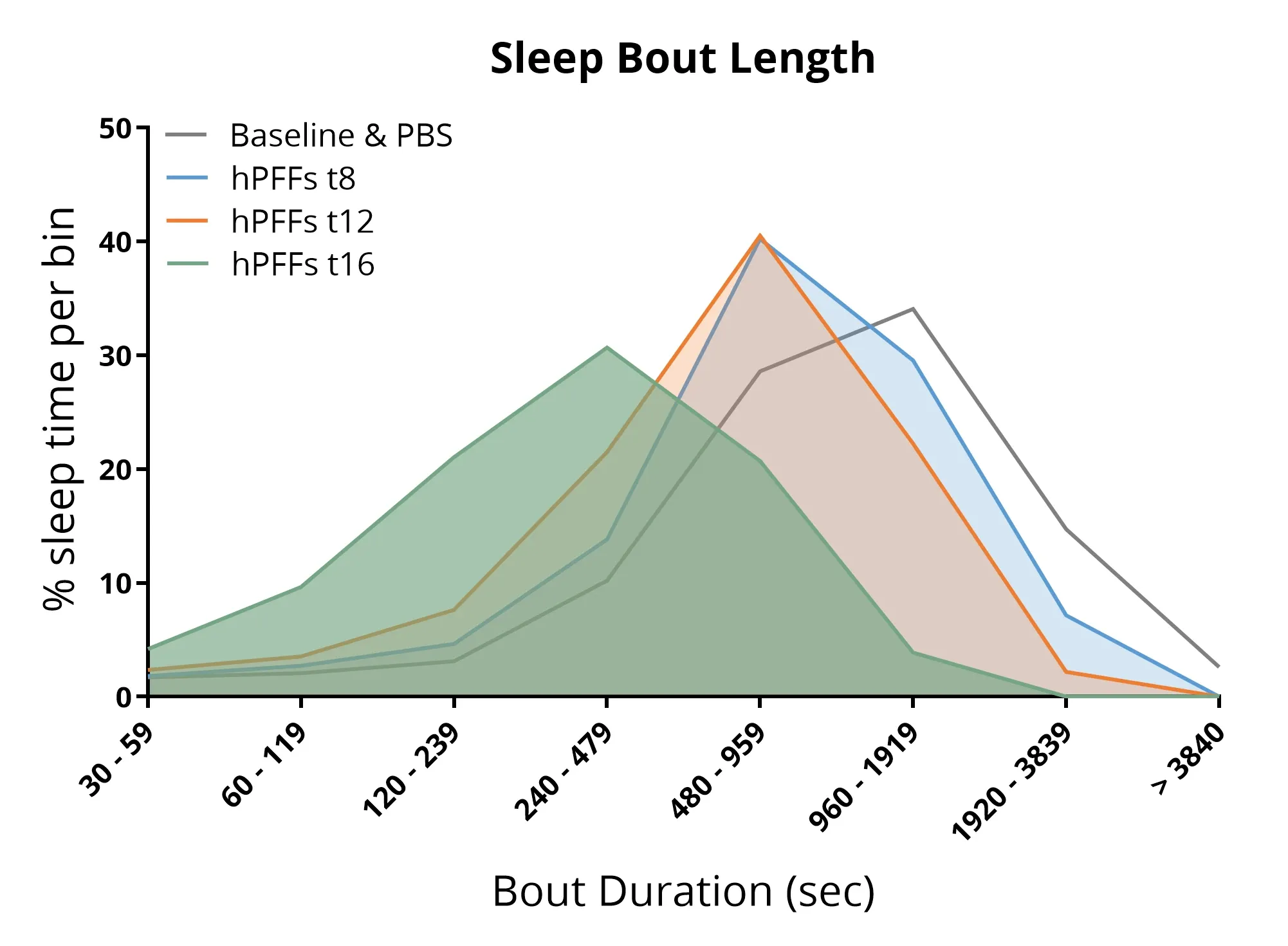
Sleep analysis showing that mice injected with α-syn PFFs into the AON exhibit disrupted sleep architecture, including shorter sleep bout lengths and reduced overall sleep duration.
Sleep Alterations
Sleep disturbances are among the most common non-motor symptoms of Parkinson's disease, affecting up to ~85% of patients (Stefani, 2020; Asadpoordezaki, 2025).
Using a non-invasive sleep monitoring system in Parkinson's disease mice, we have shown that:
- α-synuclein PFF injection into the AON of A53T transgenic mice leads to:
- Altered sleep-wake architecture
- Changes in total sleep percentage
- Disrupted sleep bout lengths
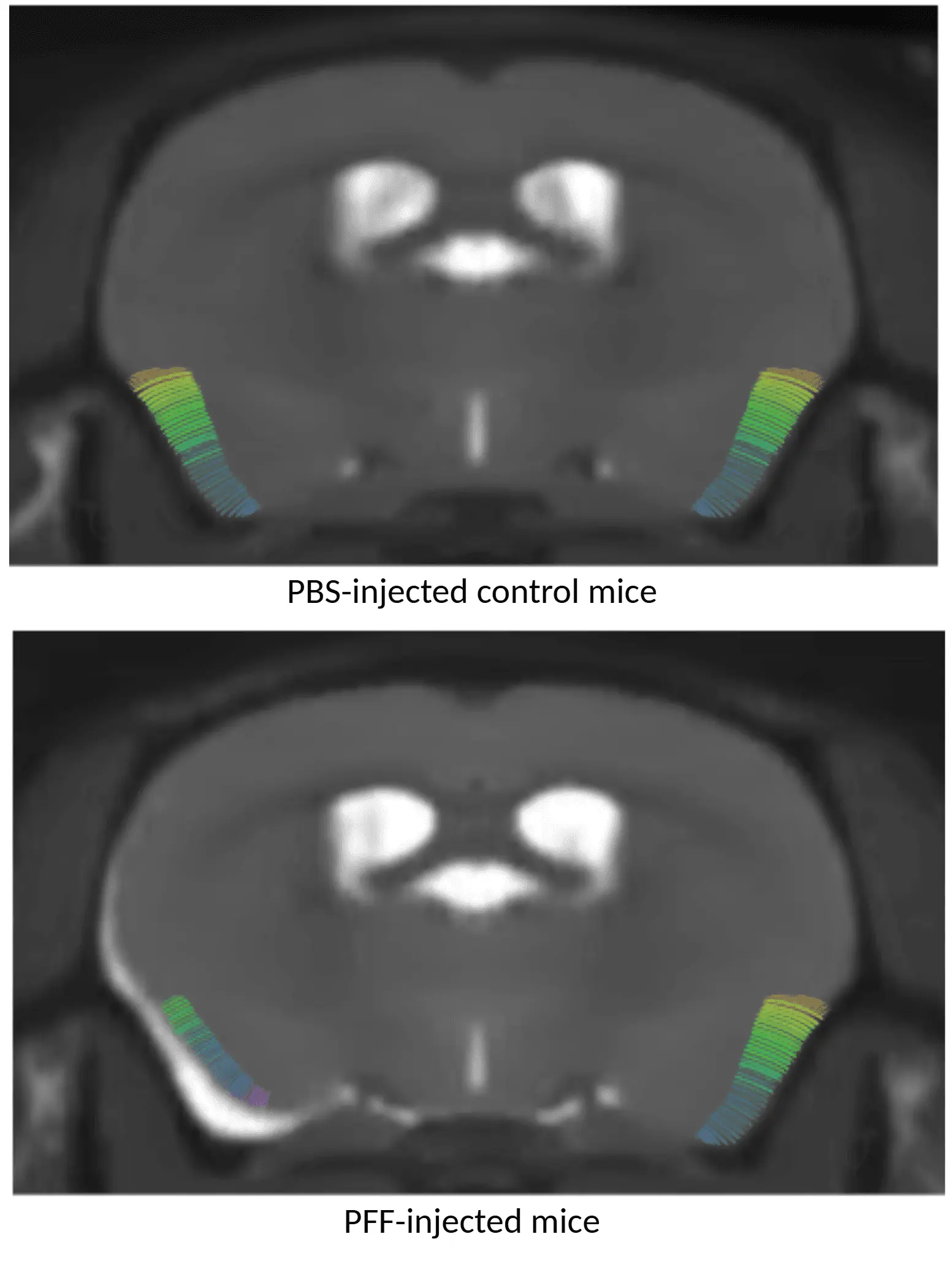
MRI cortical thickness maps showing PBS-injected mice (top) and AON α-syn PFF-injected mice (bottom), with PFF-treated animals displaying cortical thinning.
Regional Brain Atrophy
Multi-modality brain imaging biomarkers are widely used in clinical trials of Parkinson's disease. MRI-derived measures of regional neuroanatomical volumes and cortical thickness are sensitive indicators of brain atrophy in Parkinson's disease (Tremblay, 2021; Abdelgawad, 2023).
Using whole-brain, high-resolution, anatomical MRI acquisition paired with advanced fully-automated image processing & analysis, we have shown:
- Reproducible regional brain atrophy in both our AAV- and PFF-induced Parkinson's mice
See our Innovation: Brain Atrophy Analysis in Mouse Models of Neurodegeneration

α-Syn PFF-injected mice in the AON and MFB show elevated CSF NF-L levels compared to control mice.
Elevated Neurofilament Light in CSF & Plasma
Neurofilament light chain (NF-L) is elevated in the CSF and plasma of PD patients and is routinely used as a fluid biomarker in PD clinical trials (Bäckström, 2020; Urso, 2023; Pedersen, 2024). Increased NF-L levels have also been reported in several preclinical models of PD.
In our mouse models of Parkinson's disease, we observe:
- Significant increases in plasma and CSF NF-L in M83+/- transgenic mice following PFF injection of human α-synuclein into:
- The anterior olfactory nucleus (AON)
- The medial forebrain bundle (MFB)
See our Resource: Neurofilament Light Chain in Parkinson's Disease Models
What are the Pathological and Phenotypical Profiles of PFF and AAV α-Synuclein Rodent Models?
The tables below summarize the extent to which each model reproduces hallmark features of human Parkinson's disease, enabling rapid comparison of their relevance for specific research questions.
Pathology
This table outlines key PD-associated pathological features – such as α-synuclein aggregation, neuroinflammation, and dopaminergic neuron loss – and compares how robustly they emerge in PFF and AAV induced mouse models.
| Feature/Domain | PFF Models | AAV Models |
|
✔️ |
✔️ | |
|
✔️ |
✔️ | |
|
✔️ |
✔️ |
Functional Features
This table compares behavioral and physiological impairments linked to PD pathology, including motor deficits and sleep-wake disturbances, highlighting differences across mouse models.
|
Feature/Domain |
PFF Models |
AAV Models |
|
✔️ |
✔️ | |
|
✔️ |
N/A |
Biomarkers
This table summarizes non-invasive imaging and fluid-based biomarkers relevant to disease progression. These biomarkers provide quantitative endpoints for assessing neurodegeneration and evaluating therapeutic effects across the PFF and AAV inducible animal models.
|
Feature/Domain |
PFF Models |
AAV Models |
|
✔️ |
✔️ | |
|
✔️ |
✔️ |
Summary: Both PFF and AAV α-synuclein models exhibit pronounced α-synuclein pathology, with the PFF model showing characteristic seeding and spreading spatiotemporal patterns. Neuroinflammatory responses are observed in both models, whereas dopaminergic neuron loss is generally more severe and regionally selective in the AAV model. Motor impairments occur in both models, but arise earlier and with greater magnitude in the AAV model, and sleep-related phenotypes have not yet been evaluated in the AAV model. MRI-based brain atrophy and elevated NF-L serve as clinically translational biomarkers of neurodegeneration in both mouse models.
What are the Features of Parkinson's Disease Mouse Models?
The "Image Interactive" below allows you to explore our characterization of our AAV-A53T-Synuclein mouse model, including in vivo data and high-resolution images of entire Multiplex Immunofluorescence tissue sections.
You can simply navigate through the "Image Story" using the left panel.
You can pan around the high-resolution microscopy images using the left mouse button. You can zoom in and out using the mouse/trackpad (up/down) or the + and - buttons in the upper left corner. You can toggle (on/off), change color, and adjust image settings for the channels and segmentations in the Control Panel in the upper right corner.
We suggest using Full Screen Mode for the best interactive experience.
Characterization of our AAV-A53T-Synuclein mouse model, including in vivo data and high-resolution images of entire Multiplex Immunofluorescence tissue sections.
Click to copy link
Parkinson's Disease Animal Models Summary: How do PFF and AAV α-Synuclein Models Compare?
Together, the PFF and AAV α-synuclein rodent models provide complementary platforms for investigating Parkinson's disease mechanisms and evaluating therapeutic strategies. Both reproduce core pathological features of the disease, including robust α-synuclein aggregation and measurable neuroinflammation, while differing in the expression and progression of key phenotypes. The PFF model offers a strong framework for studying seeding and spreading of pathology, whereas the AAV model demonstrates more pronounced and regionally selective dopaminergic neuron loss, along with earlier and more severe motor impairments. Although sleep-related phenotypes have not yet been assessed in the AAV context, both models support the use of MRI-based brain atrophy and NF-L levels in biofluids as translational biomarkers of neurodegeneration. Collectively, these models enable a comprehensive evaluation of Parkinson's disease-relevant pathways and therapeutic effects across diverse experimental objectives.
Learn more about our characterization of our Parkinson's Disease mouse models, our validated measures, and our Preclinical Neuroscience CRO services.
Related Content
Up-to-date information on Parkinson's Disease and best practices related to the evaluation of therapeutic agents in PD animal models.
Preformed Fibrils - A Guide to Cell and Animal Models
An overview of preformed fibril-induced cell & animal models for preclinical testing of disease-modifying therapies across multiple neurodegenerative diseases.
Microglia, Astrocytes & α-Synuclein in Parkinson’s Disease
How α-synuclein influences microglia and astrocytes in Parkinson’s disease and other synucleinopathies.
AAV α-Synuclein Models for Parkinson's Disease Drug Development
Overview of adeno-associated virus (AAV) induced α-synuclein expression in mouse & rat models for use in preclinical studies of disease-modifying therapeutics.
Neurofilament Light Chain in Parkinson's Disease Models
How neurofilament light chain (NfL; NF-L) levels can be used as blood (plasma; serum) & CSF biomarkers in Parkinson's disease mouse and rat models.
Microglial Activation in an α-Synuclein PFF Mouse Model
We have quantified microglial activation, based on morphology, in an α-synuclein preformed fibril (PFF) seeding & spreading mouse model of Parkinson’s disease.
Mitophagy and Parkinson’s Disease
An overview of how impaired mitophagy can lead to neurodegeneration in Parkinson’s disease.
Autophagy, Parkinson's Disease, and Dopaminergic Neurons
An overview of how impaired autophagy can lead to pathologic changes and neurodegeneration in dopaminergic neurons in Parkinson’s disease.
Mitochondrial Dysfunction & Parkinson's Disease
An overview of how mitochondrial dysfunction is associated with neurodegeneration in Parkinson’s disease.













